
Of all the types of fish we eat in Japan, hamachi (魬, はまち, ハマチ) is a favorite among home cooks and professional chefs alike. If you go to a Japanese sushi restaurant, you will most likely find negihama maki, or Yellowtail Scallion Roll, offered as a type of maki sushi. Yellowtail is another name for hamachi.
I always have hamachi on hand (fresh or frozen) because it takes no time to prepare (20 minutes), and I can make miso soup or quick side dishes at the same time. The flavor of this Hamachi Kama (Grilled Yellowtail Collar) and its easy cooking method will make it a favorite in your home, too!

What is Hamachi Kama?
Hamachi kama (はまちのカマ) is the collar of the yellowtail located just above the gills and below the head. It is the fattiest part of the fish, making it naturally juicy, and there are two located in each yellowtail (one per side). Typically, hamachi is grilled or broiled until the skin is crisp and the inside is just cooked through. You can easily scrape the flesh off the cartilage with chopsticks.
What Is the Difference Between Hamachi and Yellowtail?
There are several names for this fish—hamachi, buri, yellowtail, or Japanese amberjack—depending on where you are. What’s the difference? It all comes down to the age and size of the fish, and different regions of Japan will also name the fish based on the way it was caught (farmed vs. wild-caught). No matter what name you see on the menu, the raw fish should have pale pink flesh with a stripe of deep red coloring.
What Does Hamachi Kama Taste Like?
The flavor of the yellowtail collar is subtle and clean. The juicy texture of the meat is comparable to mackerel, but the taste is much milder. If you’ve tried fresh hamachi sashimi, you know the flavor is delicate, rich, and slightly sweet. It pairs beautifully with citrus, which you’ll see in my recipe below.
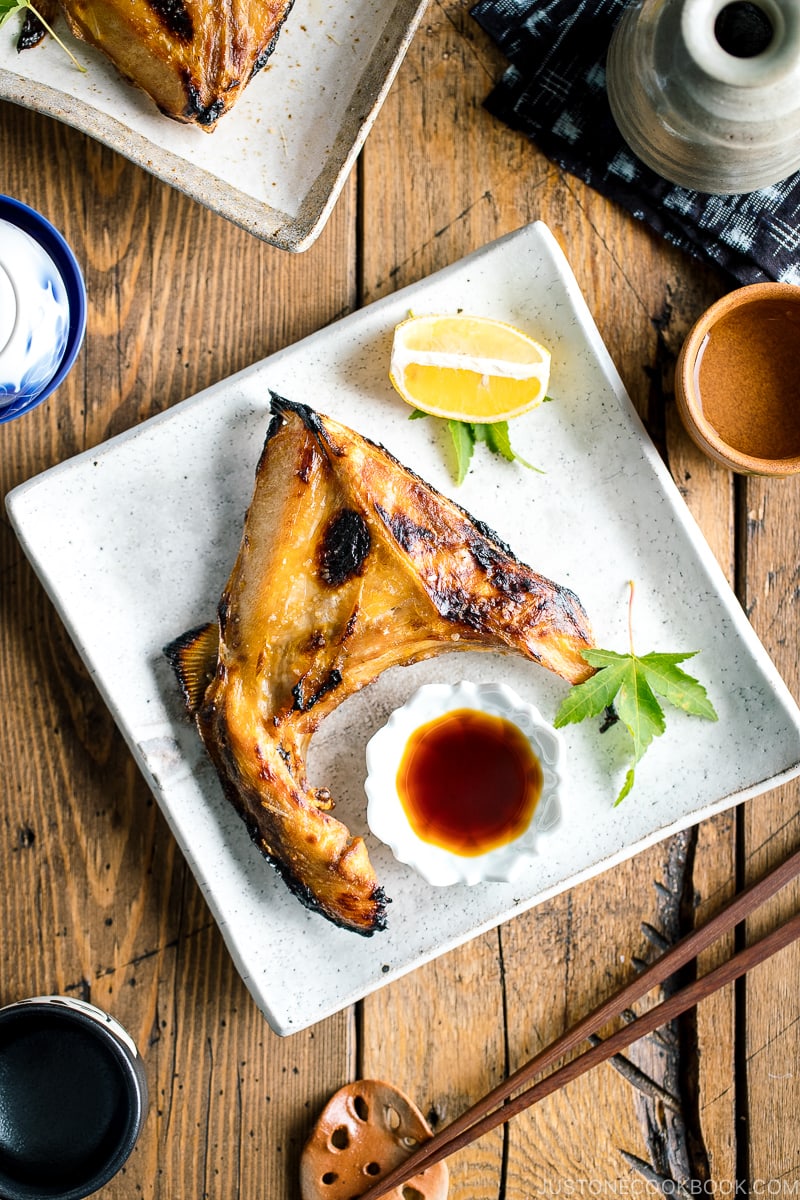
Health Benefits of Hamachi/Yellowtail
Hamachi has a number of nutritional benefits. It’s a naturally oily fish that’s high in omega-3 fatty acids (like salmon), which are important for brain and heart health. It’s also particularly high in vitamin A, vitamin D, and calcium. Like all seafood/meat, it’s important to buy good quality (it makes a difference in the flavor, too), and only consume raw hamachi if you know it is “sashimi quality.”
3 Reasons You’ll Love this Recipe
- It’s fast – Hamachi kama takes less than thirty minutes to make, so it’s perfect for busy days. There is always at least one package of hamachi kama in our freezer, which defrosts quickly under cold, running water.
- It’s easy – There is so much natural flavor in yellowtail that you don’t need much else to make it taste delicious. Before broiling the kamachi kama, brush the pan with a little oil to prevent sticking—that’s it! No need to season it because you’ll serve it with a small dish of soy sauce and yuzu juice, like a simplified version of my homemade Ponzu Sauce.
- It saves time and money – There’s no doubt a traditional Japanese dish like this would cost more at a restaurant. It can be intimidating to try new recipes at home, especially if it involves fish or meat you haven’t cooked with. But once you see how simple and truly delicious it is, you may find yourself eating out less often.
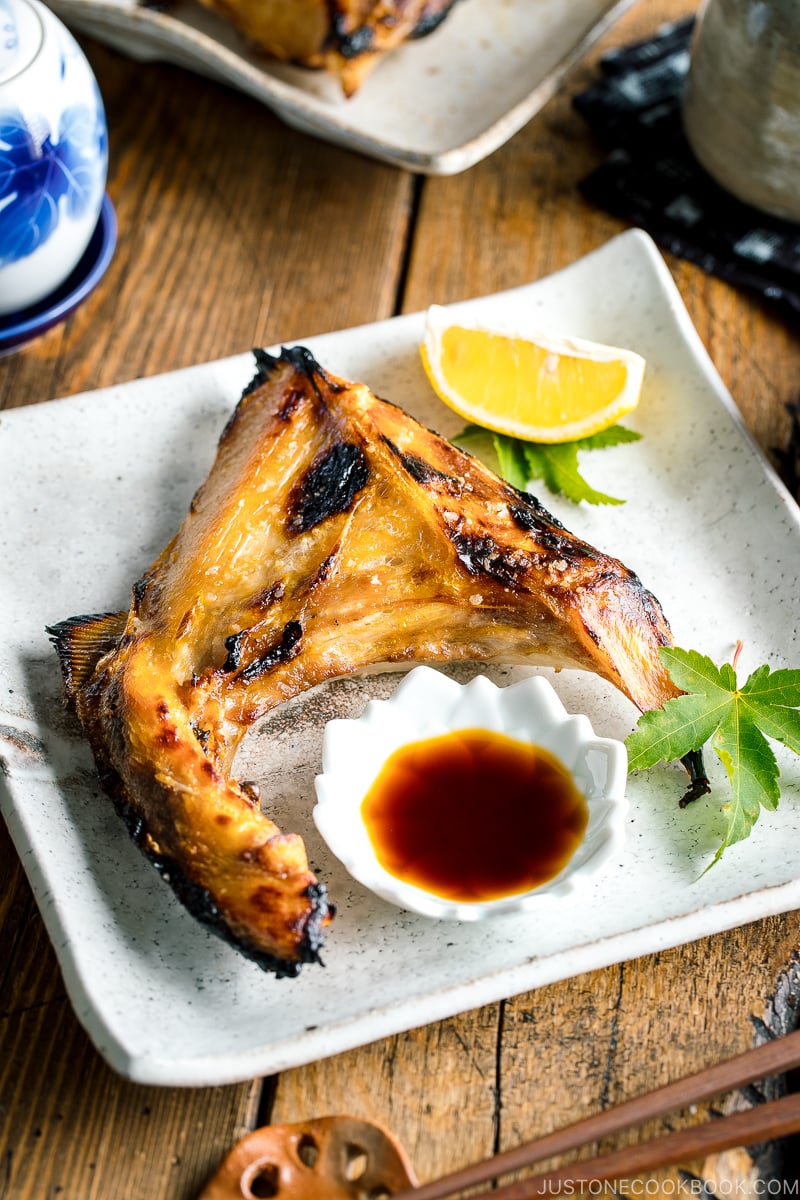
Ingredients You’ll Need
- hamachi kama (yellowtail collar)
- kosher salt – I use Diamond Crystal brand; skip the salt if you plan to lightly dip your fish in yuzu-flavored soy sauce
- soy sauce and yuzu juice (extract) – for the dipping sauce
- lemon wedges – optional, for serving
How to Make Hamachi Kama
I recommend that you broil the fish for the best results, but you could also bake it. Here’s an overview of the instructions for making this dish.
- Preheat the broiler with the rack about 6 inches (15 cm) away from the top heating element.
- Line a baking sheet with aluminum foil.
- Place the fish skin side down on the foil. Sprinkle with salt.
- Broil on the Medium setting for 8–10 minutes until lightly blistered and browned.
- Mix the soy sauce and yuzu juice. Dip the hamachi kama lightly into the sauce to enjoy.
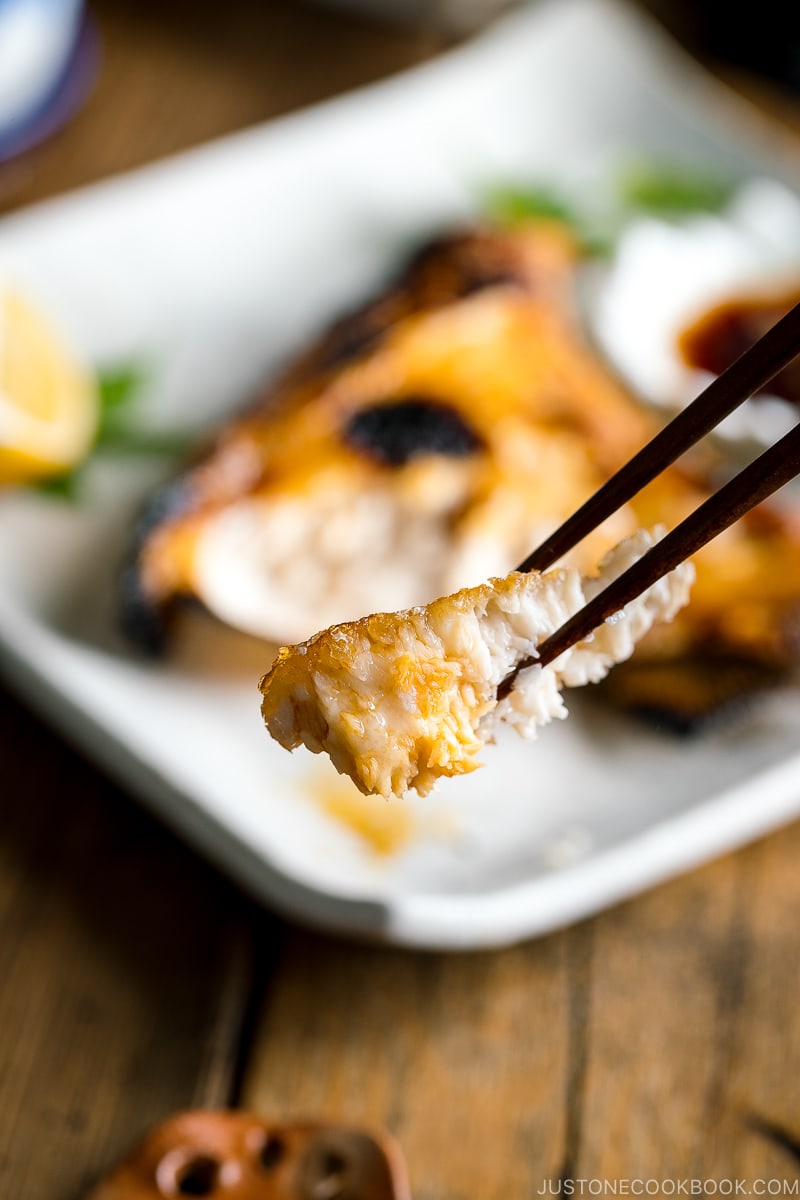
Where to Buy Hamachi Kama
Hamachi kama is available at most Japanese markets. Check the freezer section as well for individual packs of frozen hamachi kama. Korean grocery stores also sell them, sometimes at a cheaper price than Japanese markets. If you have access to a fresh seafood market, you can ask if they have “yellowtail collar” available.
More Japanese Grilled Fish Recipes You’ll Love
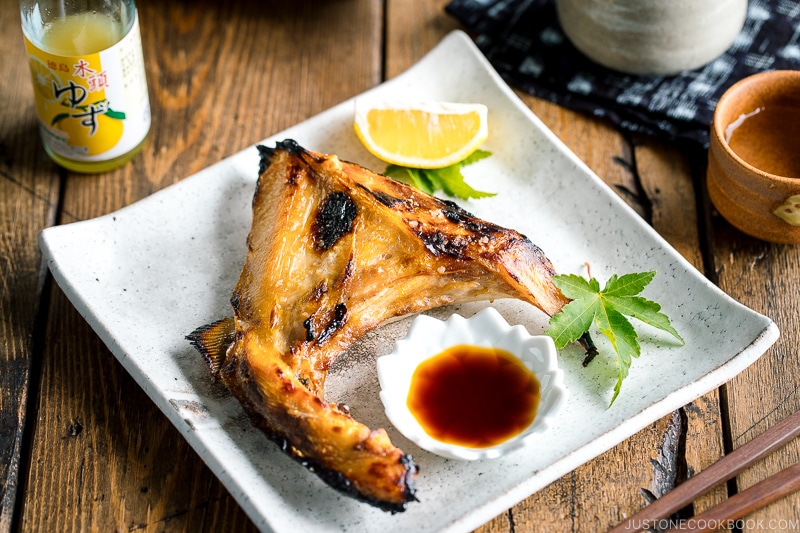
Wish to learn more about Japanese cooking? Sign up for our free newsletter to receive cooking tips & recipe updates! And stay in touch with me on Facebook, Pinterest, YouTube, and Instagram.
Hamachi Kama (Grilled Yellowtail Collar)
Ingredients
- 2 pieces hamachi kama (yellowtail collar) (11 oz, 312 g; available in Japanese markets)
- ⅛ tsp Diamond Crystal kosher salt (optional; skip if you plan to lightly dip your fish in yuzu-flavored soy sauce)
For Serving
- 1 Tbsp soy sauce
- ½ tsp yuzu juice (extract)
- 2 wedges lemon (optional)
Instructions
- Gather the ingredients. If the hamachi kama is frozen, thaw it beforehand by placing the fish, still in its vacuum-sealed package, in a bowl under a thin stream of cold running water for 20 minutes. Alternatively, you can put the fish in a bowl of iced water to defrost for 2 hours (takes longer but saves water), or in the refrigerator for 9 hours.
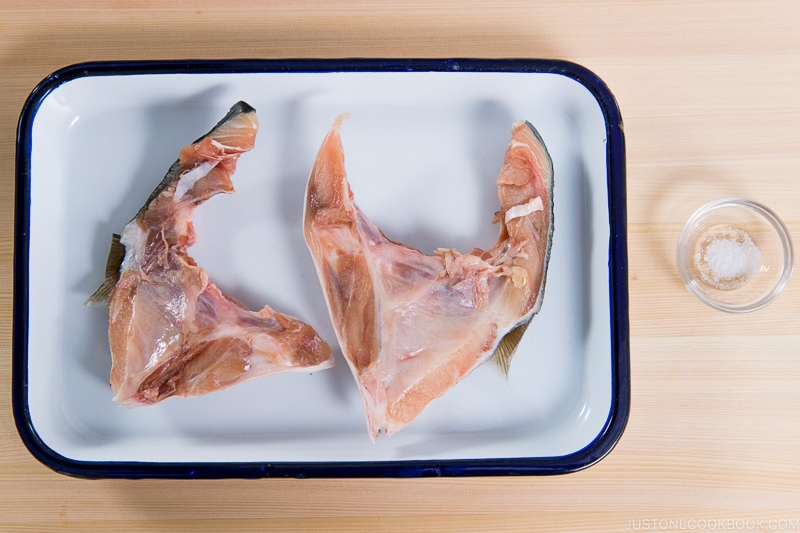
To Broil (Recommended)
- Preheat the broiler* with a rack placed about 6 inches (15 cm) away from the top heating element (in the center of the oven) for 5 minutes. When broiling, you don‘t control the temperature in the oven; instead, you control the distance between the broiler and the surface of the food. It‘s similar to using hotter and cooler zones on your grill. *Broiler setting: Low (450ºF/232ºC), Medium (500ºF/260ºC), and High (550ºF/288ºC). I usually use the Medium (6 inches away) or High (8 inches away) setting.
- Crinkle a sheet of aluminum foil and line the baking sheet. This helps prevent the fish skin from sticking to the foil.
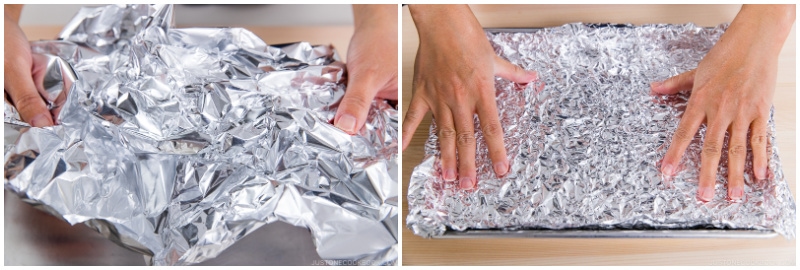
- Place 2 pieces hamachi kama (yellowtail collar) on the foil, skin side down. Sprinkle ⅛ tsp Diamond Crystal kosher salt over the fish.
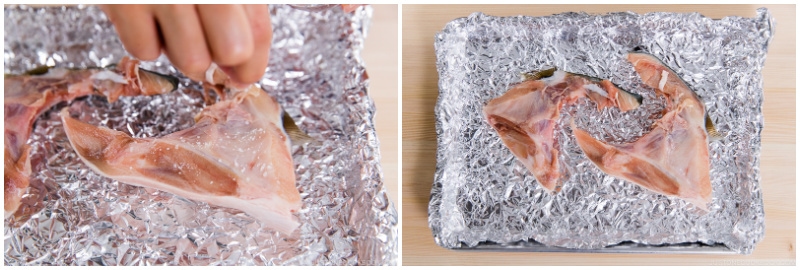
- Broil on Medium (500ºF/260°C) for 8–10 minutes until the surface is blistered and browned a bit. Please remember the cooking time varies depending on the thickness of the fish and the distance between the broiler and the food. You do not need to flip the fish. It should flake easily with chopsticks or a fork.
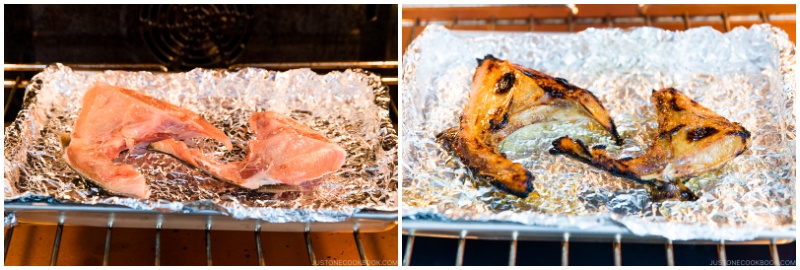
To Bake (optional)
- Preheat the oven to 425°F/218ºC with a rack placed in the middle and bake for 10–12 minutes, until the edges are crispy and the top is golden brown and opaque. A good rule of thumb to remember is to bake 5 minutes per ½ inch thickness (measure at the thickest part of the fish). You do not need to flip it. It should flake easily with chopsticks or a fork.
To Serve
- To make the yuzu-flavored soy sauce, mix 1 Tbsp soy sauce and ½ tsp yuzu juice (extract) together and divide into individual small dipping dishes. Serve the freshly grilled fish immediately on individual plates with the dipping sauce on the side and an optional 2 wedges lemon. Squeeze the lemon over the fish and dip the Hamachi Kama lightly in the sauce to eat. Enjoy!
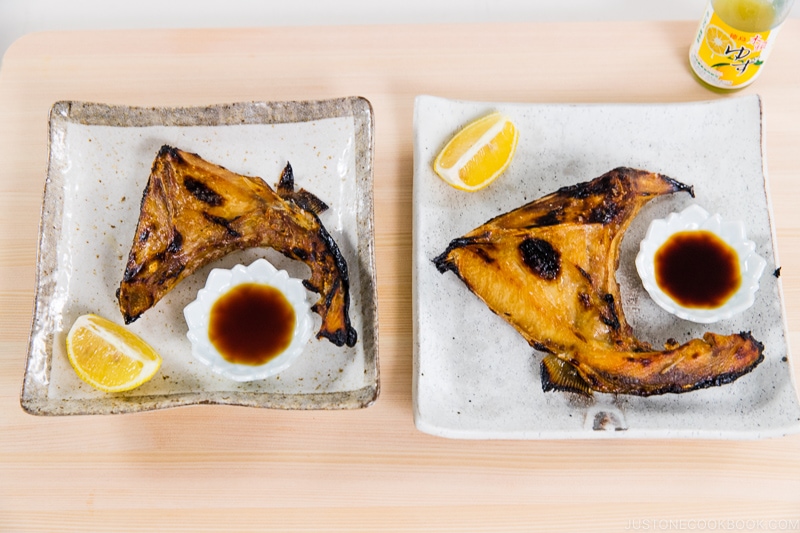
To Store
- You can keep the leftovers in an airtight container and store it in the refrigerator for up to 2 days or in the freezer for a month.
Notes
Nutrition
Did you make this recipe?
Tag @justonecookbook on Instagram so we can see your delicious creation!
Editor’s Note: The post was originally published on January 18, 2011. The images and content were updated in October 2020.


